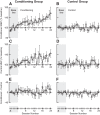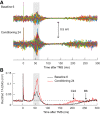Operant conditioning of the tibialis anterior motor evoked potential in people with and without chronic incomplete spinal cord injury
- PMID: 30207863
- PMCID: PMC6337029
- DOI: 10.1152/jn.00362.2018
Operant conditioning of the tibialis anterior motor evoked potential in people with and without chronic incomplete spinal cord injury
Abstract
The activity of corticospinal pathways is important in movement control, and its plasticity is essential for motor skill learning and re-learning after central nervous system (CNS) injuries. Therefore, enhancing the corticospinal function may improve motor function recovery after CNS injuries. Operant conditioning of stimulus-induced muscle responses (e.g., reflexes) is known to induce the targeted plasticity in a targeted pathway. Thus, an operant conditioning protocol to target the corticospinal pathways may be able to enhance the corticospinal function. To test this possibility, we investigated whether operant conditioning of the tibialis anterior (TA) motor evoked potential (MEP) to transcranial magnetic stimulation can enhance corticospinal excitability in people with and without chronic incomplete spinal cord injury (SCI). The protocol consisted of 6 baseline and 24 up-conditioning/control sessions over 10 wk. In all sessions, TA MEPs were elicited at 10% above active MEP threshold while the sitting participant provided a fixed preset level of TA background electromyographic activity. During baseline sessions, MEPs were simply measured. During conditioning trials of the conditioning sessions, the participant was encouraged to increase MEP and was given immediate feedback indicating whether MEP size was above a criterion. In 5/8 participants without SCI and 9/10 with SCI, over 24 up-conditioning sessions, MEP size increased significantly to ~150% of the baseline value, whereas the silent period (SP) duration decreased by ~20%. In a control group of participants without SCI, neither MEP nor SP changed. These results indicate that MEP up-conditioning can facilitate corticospinal excitation, which is essential for enhancing motor function recovery after SCI. NEW & NOTEWORTHY We investigated whether operant conditioning of the motor evoked potential (MEP) to transcranial magnetic stimulation can systematically increase corticospinal excitability for the ankle dorsiflexor tibialis anterior (TA) in people with and without chronic incomplete spinal cord injury. We found that up-conditioning can increase the TA MEP while reducing the accompanying silent period (SP) duration. These findings suggest that MEP up-conditioning produces the facilitation of corticospinal excitation as targeted, whereas it suppresses inhibitory mechanisms reflected in SP.
Keywords: corticospinal excitability; operant conditioning; plasticity; silent period; transcranial magnetic stimulation.
Figures







Similar articles
-
Operant conditioning of the motor-evoked potential and locomotion in people with and without chronic incomplete spinal cord injury.J Neurophysiol. 2019 Mar 1;121(3):853-866. doi: 10.1152/jn.00557.2018. Epub 2019 Jan 9. J Neurophysiol. 2019. PMID: 30625010 Free PMC article.
-
Operant Up-Conditioning of the Tibialis Anterior Motor-Evoked Potential in Multiple Sclerosis: Feasibility Case Studies.Neural Plast. 2018 Jul 15;2018:4725393. doi: 10.1155/2018/4725393. eCollection 2018. Neural Plast. 2018. PMID: 30123249 Free PMC article.
-
Spike-timing-dependent plasticity in lower-limb motoneurons after human spinal cord injury.J Neurophysiol. 2017 Oct 1;118(4):2171-2180. doi: 10.1152/jn.00111.2017. Epub 2017 May 3. J Neurophysiol. 2017. PMID: 28468994 Free PMC article.
-
Restoring walking after spinal cord injury: operant conditioning of spinal reflexes can help.Neuroscientist. 2015 Apr;21(2):203-15. doi: 10.1177/1073858414527541. Epub 2014 Mar 17. Neuroscientist. 2015. PMID: 24636954 Free PMC article. Review.
-
Intraoperative neurophysiological monitoring of the spinal cord during spinal cord and spine surgery: a review focus on the corticospinal tracts.Clin Neurophysiol. 2008 Feb;119(2):248-64. doi: 10.1016/j.clinph.2007.09.135. Epub 2007 Nov 28. Clin Neurophysiol. 2008. PMID: 18053764 Review.
Cited by
-
Operant conditioning of the motor-evoked potential and locomotion in people with and without chronic incomplete spinal cord injury.J Neurophysiol. 2019 Mar 1;121(3):853-866. doi: 10.1152/jn.00557.2018. Epub 2019 Jan 9. J Neurophysiol. 2019. PMID: 30625010 Free PMC article.
-
Can Operant Conditioning of EMG-Evoked Responses Help to Target Corticospinal Plasticity for Improving Motor Function in People With Multiple Sclerosis?Front Neurol. 2020 Jul 15;11:552. doi: 10.3389/fneur.2020.00552. eCollection 2020. Front Neurol. 2020. PMID: 32765389 Free PMC article. Review.
-
Number of conditioning trials, but not stimulus intensity, influences operant conditioning of brain responses after total knee arthroplasty.Knee Surg Sports Traumatol Arthrosc. 2025 Mar;33(3):967-976. doi: 10.1002/ksa.12480. Epub 2024 Sep 26. Knee Surg Sports Traumatol Arthrosc. 2025. PMID: 39324365 Free PMC article. Clinical Trial.
-
Enhancing neurorehabilitation by targeting beneficial plasticity.Front Rehabil Sci. 2023 Jun 29;4:1198679. doi: 10.3389/fresc.2023.1198679. eCollection 2023. Front Rehabil Sci. 2023. PMID: 37456795 Free PMC article. Review.
-
Operant Upconditioning of the Quadriceps Motor Evoked Torque as a Means to Improve Quadriceps Function After ACL Reconstruction.Sports Health. 2025 Feb 10:19417381251313775. doi: 10.1177/19417381251313775. Online ahead of print. Sports Health. 2025. PMID: 39930348 Free PMC article.
References
Publication types
MeSH terms
Grants and funding
LinkOut - more resources
Full Text Sources
Other Literature Sources
Medical

